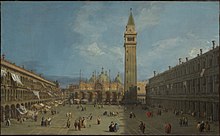Piazza San Marco

Piazza San Marco with the Basilica (1720) by Canaletto.
|
|
| Other name(s) |
|
|---|---|
| Location | Venice, Italy |
| Coordinates | 45°26′2″N 12°20′17″E / 45.43389°N 12.33806°ECoordinates: 45°26′2″N 12°20′17″E / 45.43389°N 12.33806°E |
| Construction | |
| Construction start | 800-1100 |
Piazza San Marco (Italian pronunciation: [ˈpjattsa sam ˈmarko]; Venetian: Piasa San Marco), often known in English as St Mark's Square, is the principal public square of Venice, Italy, where it is generally known just as la Piazza ("the Square"). All other urban spaces in the city (except the Piazzetta and the Piazzale Roma) are called campi ("fields"). The Piazzetta ("little Piazza/Square") is an extension of the Piazza towards the lagoon in its south east corner (see plan). The two spaces together form the social, religious and political centre of Venice and are commonly considered together. This article relates to both of them.
A remark usually attributed (though without proof) to Napoleon calls the Piazza San Marco "the drawing room of Europe".
The Square is dominated at its eastern end by the great church of St Mark. It is described here by a perambulation starting from the west front of the church (facing the length of the Piazza) and proceeding to the right.
The church is described in the article St Mark's Basilica, but there are aspects of it which are so much a part of the Piazza that they must be mentioned here, including the whole of the west facade with its great arches and marble decoration, the Romanesque carvings round the central doorway and, above all, the four horses which preside over the whole piazza and are such potent symbols of the pride and power of Venice that the Genoese in 1379 said that there could be no peace between the two cities until these horses had been bridled; four hundred years later, Napoleon, after he had conquered Venice, had them taken down and shipped to Paris.
The Piazzetta dei Leoncini is an open space on the north side of the church named after the two marble lions (presented by Doge Alvise Mocenigo in 1722), but now officially called the Piazzetta San Giovanni XXIII. The neo-classic building on the east side adjoining the Basilica is the Palazzo Patriarcale, the seat of the Patriarch of Venice.
Beyond that is the Clock Tower (Torre dell'Orologio), completed in 1499, above a high archway where the street known as the Merceria (a main thoroughfare of the city) leads through shopping streets to the Rialto, the commercial and financial centre. To the right of the clock-tower is the closed church of San Basso, designed by Baldassarre Longhena (1675), sometimes open for exhibitions.
...
Wikipedia
